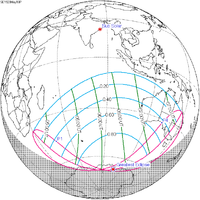| Total eclipse | |||||||||||||||||
 The Moon's hourly motion shown right to left The Moon's hourly motion shown right to left | |||||||||||||||||
| Date | May 3, 1920 | ||||||||||||||||
|---|---|---|---|---|---|---|---|---|---|---|---|---|---|---|---|---|---|
| Gamma | −0.3312 | ||||||||||||||||
| Magnitude | 1.2194 | ||||||||||||||||
| Saros cycle | 120 (53 of 84) | ||||||||||||||||
| Totality | 71 minutes, 31 seconds | ||||||||||||||||
| Partiality | 219 minutes, 39 seconds | ||||||||||||||||
| Penumbral | 360 minutes, 4 seconds | ||||||||||||||||
| |||||||||||||||||
| ← November 1919October 1920 → | |||||||||||||||||
A total lunar eclipse occurred at the Moon’s ascending node of orbit on Monday, May 3, 1920, with an umbral magnitude of 1.2194. A lunar eclipse occurs when the Moon moves into the Earth's shadow, causing the Moon to be darkened. A total lunar eclipse occurs when the Moon's near side entirely passes into the Earth's umbral shadow. Unlike a solar eclipse, which can only be viewed from a relatively small area of the world, a lunar eclipse may be viewed from anywhere on the night side of Earth. A total lunar eclipse can last up to nearly two hours, while a total solar eclipse lasts only a few minutes at any given place, because the Moon's shadow is smaller. Occurring only about 3.8 days before apogee (on May 6, 1920, at 21:00 UTC), the Moon's apparent diameter was smaller.
This lunar eclipse was the first of an almost tetrad, with the others being on October 27, 1920 (total); April 22, 1921 (total); and October 16, 1921 (partial).
Visibility
The eclipse was completely visible over South America, west and southern Africa, western Europe, and Antarctica, seen rising over much of North America and the eastern Pacific Ocean and setting over eastern Europe, east Africa, and the western half of Asia.
 
|
Eclipse details
Shown below is a table displaying details about this particular solar eclipse. It describes various parameters pertaining to this eclipse.
| Parameter | Value |
|---|---|
| Penumbral Magnitude | 2.28178 |
| Umbral Magnitude | 1.21939 |
| Gamma | −0.33118 |
| Sun Right Ascension | 02h39m30.8s |
| Sun Declination | +15°32'26.3" |
| Sun Semi-Diameter | 15'51.7" |
| Sun Equatorial Horizontal Parallax | 08.7" |
| Moon Right Ascension | 14h39m15.0s |
| Moon Declination | -15°50'11.0" |
| Moon Semi-Diameter | 14'55.8" |
| Moon Equatorial Horizontal Parallax | 0°54'47.6" |
| ΔT | 21.5 s |
Eclipse season
See also: Eclipse cycleThis eclipse is part of an eclipse season, a period, roughly every six months, when eclipses occur. Only two (or occasionally three) eclipse seasons occur each year, and each season lasts about 35 days and repeats just short of six months (173 days) later; thus two full eclipse seasons always occur each year. Either two or three eclipses happen each eclipse season. In the sequence below, each eclipse is separated by a fortnight.
| May 3 Ascending node (full moon) |
May 18 Descending node (new moon) |
|---|---|
 |

|
| Total lunar eclipse Lunar Saros 120 |
Partial solar eclipse Solar Saros 146 |
Related eclipses
Eclipses in 1920
- A total lunar eclipse on May 3.
- A partial solar eclipse on May 18.
- A total lunar eclipse on October 27.
- A partial solar eclipse on November 10.
Metonic
- Preceded by: Lunar eclipse of July 15, 1916
- Followed by: Lunar eclipse of February 20, 1924
Tzolkinex
- Preceded by: Lunar eclipse of March 22, 1913
- Followed by: Lunar eclipse of June 15, 1927
Half-Saros
- Preceded by: Solar eclipse of April 28, 1911
- Followed by: Solar eclipse of May 9, 1929
Tritos
- Preceded by: Lunar eclipse of June 4, 1909
- Followed by: Lunar eclipse of April 2, 1931
Lunar Saros 120
- Preceded by: Lunar eclipse of April 22, 1902
- Followed by: Lunar eclipse of May 14, 1938
Inex
- Preceded by: Lunar eclipse of May 23, 1891
- Followed by: Lunar eclipse of April 13, 1949
Triad
- Preceded by: Lunar eclipse of July 2, 1833
- Followed by: Lunar eclipse of March 3, 2007
Lunar eclipses of 1919–1922
| This section is empty. You can help by adding to it. (December 2024) |
Half-Saros cycle
A lunar eclipse will be preceded and followed by solar eclipses by 9 years and 5.5 days (a half saros). This lunar eclipse is related to two total solar eclipses of Solar Saros 127.
| April 28, 1911 | May 9, 1929 |
|---|---|

|

|
See also
Notes
- "May 2–3, 1920 Total Lunar Eclipse (Blood Moon)". timeanddate. Retrieved 16 December 2024.
- "Moon Distances for London, United Kingdom, England". timeanddate. Retrieved 16 December 2024.
- "Total Lunar Eclipse of 1920 May 03" (PDF). NASA. Retrieved 16 December 2024.
- "Total Lunar Eclipse of 1920 May 03". EclipseWise.com. Retrieved 16 December 2024.
- Mathematical Astronomy Morsels, Jean Meeus, p.110, Chapter 18, The half-saros
External links
- 1920 May 03 chart Eclipse Predictions by Fred Espenak, NASA/GSFC
This lunar eclipse-related article is a stub. You can help Misplaced Pages by expanding it. |


